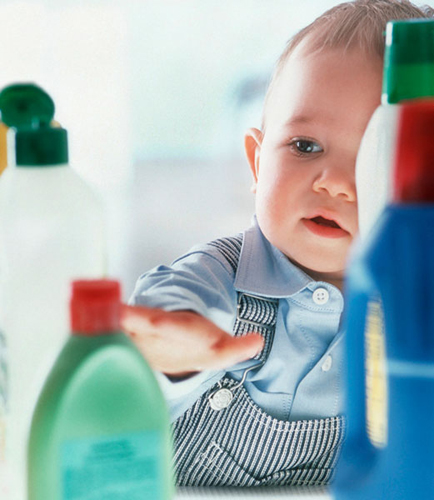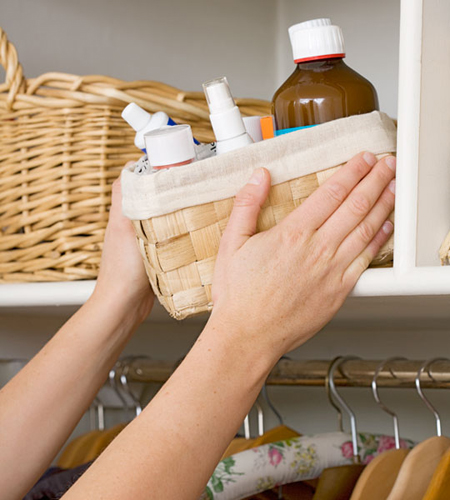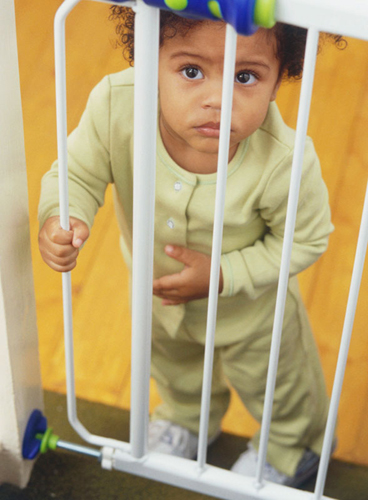Safety in the home Things to be aware of
Try getting down on your hands and knees and crawling around your home from ground level to do a safety check space by space:
From around six to eight months, as your baby’s physical development accelerates, his motor skills will start to match his burgeoning curiosity. He can wriggle, kick, roll, crawl, grab, pull, “bottom shuffle,” and eventually walk and climb. In order to safely encourage his exploration and learning (without constantly having to warn him not to touch), now is the time to make your home and surroundings as hazard-free as possible.
In the US, accidents are one of the biggest causes of death in children, and many of these are in the home. Every week hundreds of preschoolers are admitted to accident and emergency rooms due to falls, burns, and suspected poisoning.
Your small child will be intrigued by things that are kept locked away or put on high shelves, especially if they are in brightly colored bottles or shiny wrappings. Child safety gadgets range from helpful to essential, but can never be a substitute for your attention and supervision. Do not leave your child unsupervised in any room in your house or in your yard (or in anyone else’s). Always know where your child is and what he is doing. Lots of interesting activities and games to keep him busy are the best prevention against unwanted risks.
The kitchen
This is a hazardous place and probably where you and your baby spend a lot of time. You can’t be watching him all the time, so it is worth considering the following points.
Store knives, sharp objects, lighters, and matches out of reach. Turn saucepan handles toward the back of the stove and use the back burners. Put hot drinks out of reach, and don’t drink or pass them over your baby’s head. Ensure that cords from toasters and other countertop appliances are tucked away. Keep plastic bags out of reach.
Mop up spills immediately and keep floors clear and clutter-free. Keep household chemicals out of sight and reach. Alcohol, aromatherapy oils, cigarettes, perfume, and mouthwash can all be poisonous to children. Remember that child-resistant lids aren’t entirely childproof.
Use a barrier or playpen while you are cooking. Use safety covers for electrical sockets, safety corners for sharp edges, a stove guard, and child-proof locks for low cupboards. To prevent choking, keep anything small out of reach—including coins, and hard foods such as pieces of raw carrot.
The bathroom
This is probably the next priority in your safety audit. A frequently used space for water play, bubbles, and stories while you are toilet training, it should be safe and anxiety free.
Store medicines in a high cupboard with a child-resistant catch. Be extra careful with pills in shiny, colorful blister packs. Never leave them lying around, and if you need to take medication do so when your child is not around, because he will copy you. Don’t keep medicines on your bedside table, or in your handbag. Put lids back on bottles and put them away immediately after use. Take left-over medicines to the pharmacy for safe disposal.
Run the cold tap in the bath first and then add the hot water to prevent scalding. Use non-slip mats in baths, showers, and on the bathroom floor.
Your hall, stairs, and landing
Can present you with some unsuspected hazards on your endless trips from room to room and floor to floor.
If the gaps between your banisters are more than 2.5 inches (6.5 cms), cover them up with boards or safety netting, as a determined youngster could squeeze herself through. Think about fitting safety glass in doors and windows or cover glass with safety film.
When carrying your baby downstairs, always have a hand free to hold on to the bannister, and keep stairs clear of clutter. Use gates at the top and bottom of stairs. Teach your child how to climb down stairs safely when he starts to be more mobile.
Never allow a small child to carry a baby downstairs.
In bedrooms and living areas
Toys and play tend to feature day to day in these places. Bear in mind the following points.
Secure heavy furniture to the wall to prevent it from toppling over. Avoid having furniture under windows and fit window catches. Doors and doorways can be made safer with door wedges and other gadgets to prevent little fingers from being jammed in them.
Fit smoke alarms and fire guards, and get all heating appliances safety checked.
Never leave candles or tea lights unattended.
Change your baby on the floor, preferably, and never leave him unattended on a raised surface.
Keep an eye on his crib toys—once he can get up onto all fours, he can use them to climb out of his crib.
Your outdoor space
This presents a treasure trove of exploratory possibilities, and will be fascinating to your child. It needs a careful safety once-over.
Tools and equipment need to be stored securely and put away after use. Your child will be less interested in your garden and home-repair tools if he has a set of his own (use play tools designed for children).
Paint, mineral spirits, pesticides, and antifreeze must be securely stored out of sight and reach, under lock and key. As with indoor chemicals, always keep them in their original containers to avoid any confusion.
Enclose and cover ponds and pools, and take extra care around bonfires, barbeques, and garden lanterns and candles.
Do a first-aid course, learning infant CPR and how to deal with minor injuries, in case of accidents.
Safety check
Be careful in other people’s houses, especially those without young children—they may not have taken the same precautions.

Out of reach
Store medication out of reach and preferably where your child cannot see it. Dispose of leftover medicines at the pharmacy.

Not a game
Toddlers frequently see the stairs as an adventure course to be explored, so install gates at the top and bottom of your stairs.
